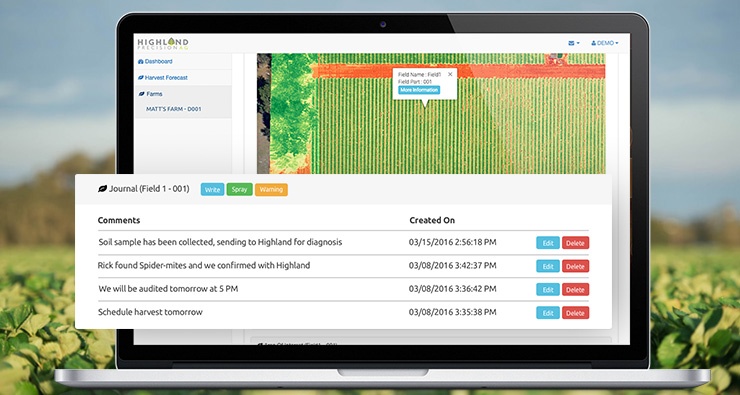Big data, by definition, is extremely large sets of data that may be analyzed computationally to reveal patterns, trends and associations.
In agriculture, big data refers to all of the information being collected by various agriculture technologies or farm employees. This information canbe biological, environmental, or even logistical and production data. It can also be georeferenced, allowing farmers to monitor specific parts of their fields.
LEARN MORE ABOUT OUR ALL-IN-ONE FARM MANAGEMENT PLATFORM.
Christopher Crockett, Highland’s Director of Research and Development, gives us more insight into why big data is important to the future of farming.
WHAT TYPE OF DATA IS COLLECTED FROM PRECISION AGRICULTURE PRACTICES?
Pretty much anything you can think of, ranging the full gamut of biological to environmental to logistical and production data. If there is a sensor or person that can record a piece of information in a georeferenced way, it can be collected and used for precision agriculture purposes.
We can collect soil nutrient data and mark where it comes from in a field. We can take imagery and measure the types of light being reflected by plants. We can have sensors measuring the flow of water coming from each pump house. We can keep track of yields in a given field, or even in a given row if we have a mechanical harvester.
 WHAT ARE THE BENEFITS OF HAVING THIS LARGE AMOUNT OF DATA?
WHAT ARE THE BENEFITS OF HAVING THIS LARGE AMOUNT OF DATA?
We collect data to obtain an understanding of reality. The more accurate data we obtain, coupled with hands-on analyses gives us a better understanding of the farm, and thus a better way to make informed decisions about the observable world.
Many of our traditional approaches involve using one or just a few variables to explain the patterns we see. Big data allows us to incorporate a far greater number of variables to start understanding those patterns even better. We can even train computers using big data to aid in the decision making process.
These “machine learning” techniques allow a computer to accomplish subsequent tasks without being explicitly programmed to do so. The bigger and better the data we put into these techniques, the better the programs will be at adapting to new data in the future.

HOW DOES HAVING THIS DATA MAKE LIFE EASIER FOR THE FARMER?
All of these approaches sound highly technical and disconnected from farming. But at the end of the day, these techniques will lead to a very simple answer for the farmer to incorporate into their day-to-day decision making process.
While there is a whole lot of math that’s going into computing how all of these different variables interact with each other, at the end of it all the farmer will get a very specific answer to a problem (i.e. “There is an 85% likelihood of spider mites affecting this part of the field.”).
We can also set crop specific thresholds and warnings for any of the data we collect. If we know that a certain level of light reflected from the plant combined with a certain measurement of soil moisture is resulting in low yields and needs to be treated in a particular way, the grower could get an alert and a recommendation—which they can go and ground truth themselves if they wanted to.
As these data sets build and we gain the ability to make better predictions, the grower’s level of management effort will decrease as they can rely more upon these predictions.
WHAT WOULD YOU SAY TO FARMERS WHO WOULDN’T KNOW WHAT TO DO WITH ALL OF THAT DATA?
You don’t have to know what to do with it all. Our goal is not to hand over a bunch of raw data to a grower. It is to hand over answers once we’ve run through all of the data.
HOW DOES HIGHLAND PRECISION AG APPROACH THE USE OF FARMER DATA? WHY DOES HPA APPROACH THIS DIFFERENTLY?
A farm has to be thought of more like a superorganism than a machine, and we fully embrace this at HPA. We understand that farms exist in a complex landscape with other farms, and the environment in which all of these farms exist in must be taken into account.
Farming has always been a community effort. Precision agriculture is also a community effort. Much like the medical field, we will take farmer data, anonymize that in our system and analyze it with other data from all the farms in a particular area. This will allow us to understand the problems that many farmers face as an area-wide issue instead of an individual issue, giving us the ability to create better solutions for a given farm based on where it exists in that area.
We also store all of this data to continuously reanalyze over time as we collect more data in hopes of refining our predictive approaches. The more data we obtain from farms the better we’re going to be at giving simple answers and advice to growers.
LEARN MORE ABOUT HIGHLAND PRECISION AG
At Highland, we believe that data being collected by agriculture technologies should only be utilized to benefit the grower. That’s why all of the data our team collects is automatically digested and placed in a secure, easy-to-view dashboard that a grower can access at any time with little to no effort.
For more information about how Highland Precision Ag is helping growers find solutions to complex challenges, visit our website or contact us today with any questions you may have.